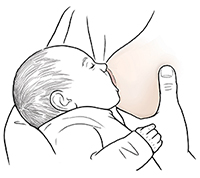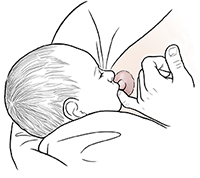How to Breastfeed
How to Breastfeed
Babies use their lips, gums, and tongue to take milk from the breast (suckle). Your baby is born with an instinct for suckling. But it takes time for you and your baby to learn how to breastfeed. There are steps you can take to support your baby’s natural instincts.
Skin-to-skin
If possible, hold your baby bare against your skin (skin-to-skin) just after giving birth and for a few hours after. You can also continue to do this in the first few weeks after birth.
How often should I feed my baby?
Nurse your newborn 8 to 12 times every 24 hours. Feed your baby whenever he or she shows signs of hunger. When your baby is hungry, he or she will appear more awake and might root. Rooting means turning his or her head toward you when you stroke your baby’s cheek. Your baby might also make a sucking sound or suck on his or her hand. Crying is a late sign of hunger. If your baby is crying, it may be hard for him or her to calm down to breastfeed. Infants will often eat at irregular times. But feedings will usually become more regular over time. Sometimes your baby might eat several times in a row (cluster feeding) and then take a break.
If your baby seems sleepy or too fussy to nurse, undress him or her and place your baby bare against your skin. Don't keep your baby swaddled tightly. This may keep him or her too sleepy to feed.
Change which breast you offer first with each feeding. For example, if you started nursing on the right side with the last feeding, offer the left side first with this feeding. Always offer the other breast after your baby stops nursing on the first side.
Ask your baby's healthcare provider about waking the baby for feeding. You may need to wake your baby and offer to nurse if it has been 4 hours since your baby's last feeding.
Offering your breastHold your breast with your thumb on top and fingers underneath in a loose grip. Gently stroke your nipple on your baby’s lower lip. When you see your baby open his or her mouth wide, quickly bring the baby to your breast. |
|
Latching onThe way your baby connects with the breast is called the latch. When your baby attaches, you should see more of the darker skin around the nipple (areola) above the baby's upper lip than below the lower lip. The front of your baby's entire body should be touching you. Your baby's nose and chin should be against the breast. |
|
Releasing the latchLet your baby nurse until satisfied. In most cases, when your baby is finished nursing, he or she will let go on his or her own. This tells you that your baby is done feeding on that breast. But you may need to release the latch sooner if you feel pain or for some other reason. To do this, slip your finger into the corner of your baby's mouth. You should feel the suction break. Only when the seal is broken, move your baby off your breast. Don't take the baby off your breast until you've felt a decrease in suction. |
Burping your baby
Breastfed babies don't need to burp as much as bottle-fed babies. Bottles flow faster, and babies tend to swallow more air. Try to burp your baby after each breast:
Hold the baby at your upper chest or slightly over your shoulder. Gently rub or pat the baby’s back.
Or hold the baby sitting up on your lap. Support your baby's head and chest in front and in back. Slowly rock your baby back and forth.
Don’t worry if your baby doesn't burp. He or she may not need to.
Updated:
April 19, 2018
Sources:
Breastfeeding and the Use of Human Milk. American Academy of Pediatrics. Pediatrics. 2012, is.129, ed.3, pp. e826-842.
Reviewed By:
Freeborn, Donna, PhD, CNM, FNP,Godsey, Cynthia, MSN, APRN, MSHE, FNP-BC,Image reviewed by StayWell medical illustration team.


